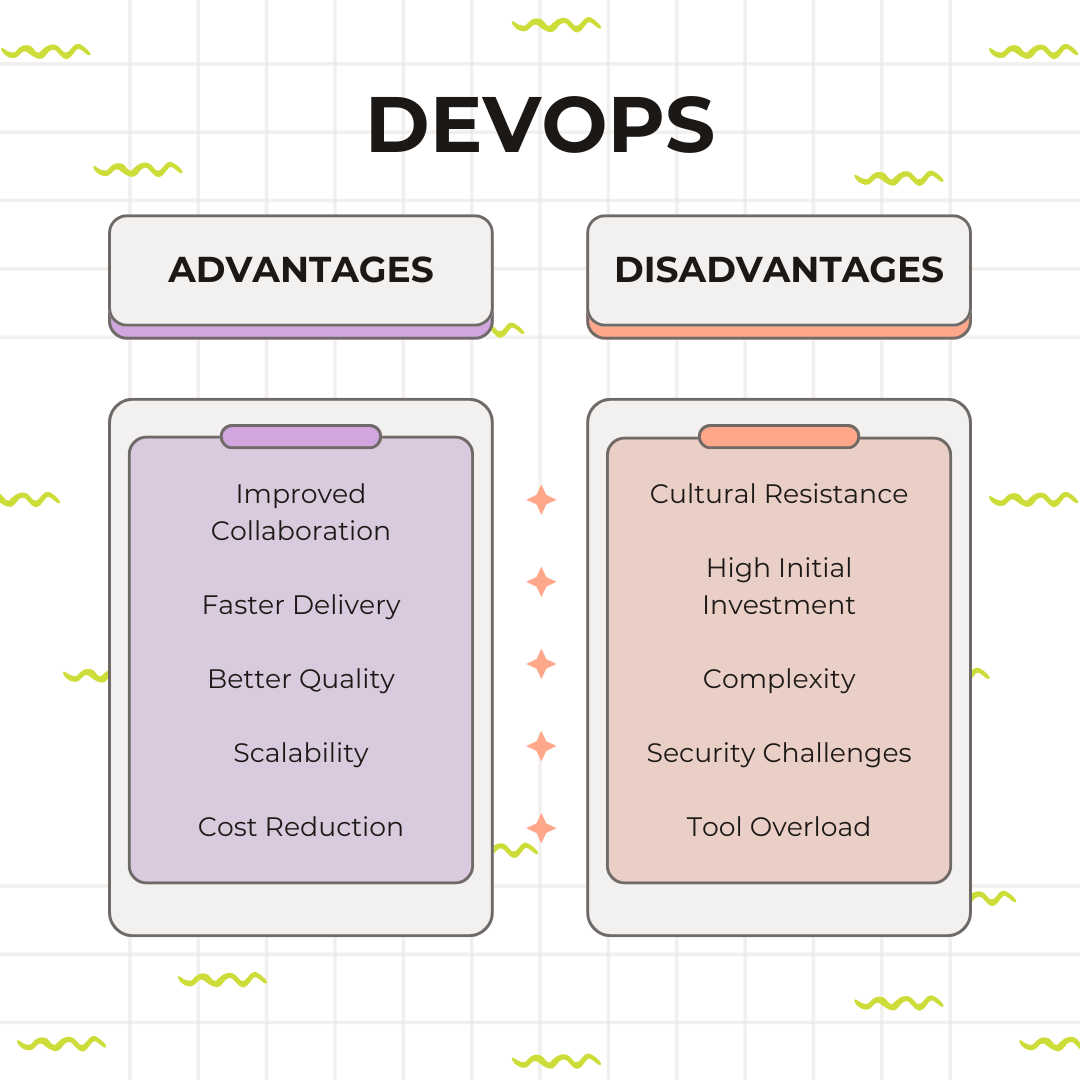Introduction
In today’s fast-paced tech environment, traditional software development and operations teams often struggle with slow processes and miscommunication. This disconnect can cause delays and frequent errors, frustrating both teams and users.
DevOps emerges as a solution, aiming to streamline collaboration and automation. However, while it promises faster delivery and better scalability, adopting DevOps also brings challenges such as cultural resistance and high initial costs. In this article, we’ll explore the pros and cons of DevOps to help you decide if it’s right for your business.
What is DevOps?
DevOps is a collaborative methodology that combines software development (Dev) and IT operations (Ops) to optimize workflows and boost productivity. Its primary goal is to break down the traditional silos between these teams, fostering better communication and coordination throughout the product lifecycle.
Core principles of DevOps encompass automation, continuous integration, and continuous delivery (CI/CD). Automation reduces manual tasks, while CI/CD ensures faster and more frequent software updates. This results in shorter development cycles, improved quality, and faster time-to-market.
At its core, DevOps emphasizes a culture of collaboration. Development and operations teams work together to quickly identify and resolve issues, ensuring software is more reliable. DevOps also promotes scalability, enabling organizations to adjust infrastructure and processes as business needs evolve.
The Advantages of DevOps
Adopting DevOps offers numerous benefits for organizations looking to improve software development and operations.
- Improved Collaboration: DevOps promotes a culture of teamwork between development and operations teams, dismantling silos and enhancing communication.
- Faster Delivery: With continuous integration and continuous delivery (CI/CD), DevOps speeds up software release cycles, allowing for quicker updates and faster feedback loops.
- Better Quality: Automation and continuous testing reduce human error and improve the overall quality of software, resulting in more stable releases.
- Scalability: DevOps enables teams to scale both infrastructure and processes efficiently, adapting to business needs as they grow.
- Cost Reduction: Automation reduces manual effort, lowering operational costs and improving resource management. By minimizing downtime and streamlining workflows, organizations can maximize their cost efficiency.
The Disadvantages of DevOps
While DevOps offers many benefits, there are challenges to consider before adoption.
- Cultural Resistance: Transitioning to DevOps can be difficult due to resistance from teams used to traditional workflows. Changing the mindset across departments requires significant effort.
- High Initial Investment: The cost of DevOps tools, infrastructure upgrades, and training can be high, especially for smaller organizations.
- Complexity: Integrating various tools and automating processes can be complex, requiring advanced technical skills.
- Security Challenges: Continuous deployment may increase the risk of overlooking security measures if not properly integrated into workflows.
- Tool Overload: Managing and integrating multiple tools can complicate workflows and increase maintenance efforts.

DevOps Best Practices
To successfully implement DevOps, certain best practices are essential:
- Automation: Automating processes like testing, deployment, and infrastructure management is key to reducing manual errors and improving efficiency. CI/CD pipelines ensure seamless software delivery.
- Monitoring: Continuous monitoring and feedback loops help teams detect and resolve issues in real time, ensuring high system reliability and performance.
- Security Integration: Incorporating security early in the development process, known as DevSecOps, ensures that security measures are continuously addressed alongside development and operations.
Comparing DevOps with Other Methodologies
When evaluating DevOps, it's helpful to compare it with other development methodologies to understand its unique advantages and limitations. Here’s a concise comparison:
DevOps vs. Agile: Agile focuses on iterative development, continuous feedback, and collaboration within development teams. While Agile aims to enhance development efficiency, DevOps extends these principles to include operations, fostering collaboration across the entire software lifecycle.
DevOps integrates Agile’s iterative approach with continuous integration, delivery, and deployment, aiming to improve both development and operations processes.
DevOps vs. Waterfall: Waterfall is a traditional, linear approach where each phase of development is completed before moving to the next. This methodology often results in longer release cycles and less flexibility to change once development is underway. In contrast, DevOps promotes continuous delivery and integration, allowing for more frequent updates and greater adaptability.
DevOps emphasizes iterative improvements and collaboration throughout the lifecycle, addressing the inflexibility and delays associated with Waterfall.
DevOps vs. Scrum: Scrum is a framework within Agile focusing on iterative development with fixed-length sprints and regular reviews. While Scrum enhances development efficiency and responsiveness, it doesn’t inherently address operational concerns.
DevOps complements Scrum by extending Agile practices to operations, integrating continuous deployment, and automating processes to streamline both development and operational tasks.
Key Takeaways
- Improved Collaboration: DevOps enhances teamwork between development and operations, speeding up processes.
- Faster Delivery: Continuous integration and automation lead to quicker software releases.
- Challenges: High initial costs, cultural resistance, and security concerns can hinder implementation.
- Best Practices: Automation, continuous monitoring, and integrated security are essential for success.
- Comparison: DevOps goes beyond Agile and Waterfall by addressing the entire software lifecycle, including operations and continuous delivery.
Conclusion
DevOps offers significant benefits, including improved collaboration, faster delivery, better quality, scalability, and cost reduction. However, challenges like cultural resistance, high costs, complexity, and security issues must be addressed.
Organizations should carefully evaluate their needs and readiness for change to effectively implement DevOps. By focusing on best practices and preparing for potential challenges, teams can maximize the advantages of DevOps and drive successful outcomes.

